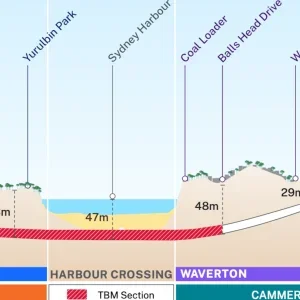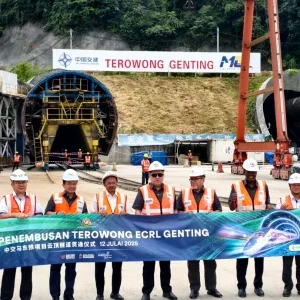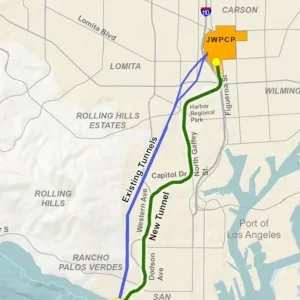The TBMs will excavate the two 57.5km-long tubes of the tunnel, which accounts for the main work of the new Lyon-Turin freight and passenger railway line.

From left: Martin Herrenknecht, Tunnel Euralpin Lyon-Turin (TELT) deputy general director Maurizio Bufalini, TELT president Daniel Bursaux, and DG Move European Commission representative Wojciech Sopinski
The 10.4m-diameter, 180m-long Herrenknecht TBM will be operated by CO 6-7, a French-Italian group of companies comprising Vinci Construction Grands Projets, Webuild, Dodin Campenon Bernard and Campenon Bernard Centre Est.
The TBM will excavate the 9km of the northern tube of the base tunnel, between Saint-Martin-la-Porte and La Praz, running parallel with the section completed in 2019 by the Federica TBM. The 2,300t machine has 61 rotating cutters and will install rings comprising eight segments of reinforced concrete.
It was designed, manufactured, and assembled in a record 10 months at Herrenknecht‘s plant in Schwanau. It will now be disassembled and transported in 130 convoys from the factory to the Saint-Martin-la-Porte platform.
Two more TBMs are being built for the section between La Praz and Modane.
Tunnel Euralpin Lyon-Turin (TELT) deputy general director Maurizio Bufalini said the final contract for the Italian side of the project would be awarded by September and the construction phase was now “at full speed”. There were 10 construction sites open, excavating 500m of tunnel a month using traditional methods.
“With the arrival of the first TBM we are marking the start of the mechanised phase which will lead us to multiply the project of work,” said Bufalini.
Once completed, the Mont Cenis base tunnel will be one of the longest rail tunnels in the world with a total of 115km of tunnels forming part of the Lyon-Turin railway. It is the primary section of the Mediterranean Corridor – the TEN-T European rail network axis linking the Iberian Peninsula to eastern Europe. When completed, rail speeds across the Alps will increase to 220km/hr for passenger services and 120km/hr for freight. It is anticipated the new line will remove more than one million lorries from alpine roads.
DG Move European Commission representative Wojciech Sopinski described the Lyon-Turin railway as one of the most ambitious infrastructure projects in Europe and said it was the “backbone” of the EU TEN-T policy.







